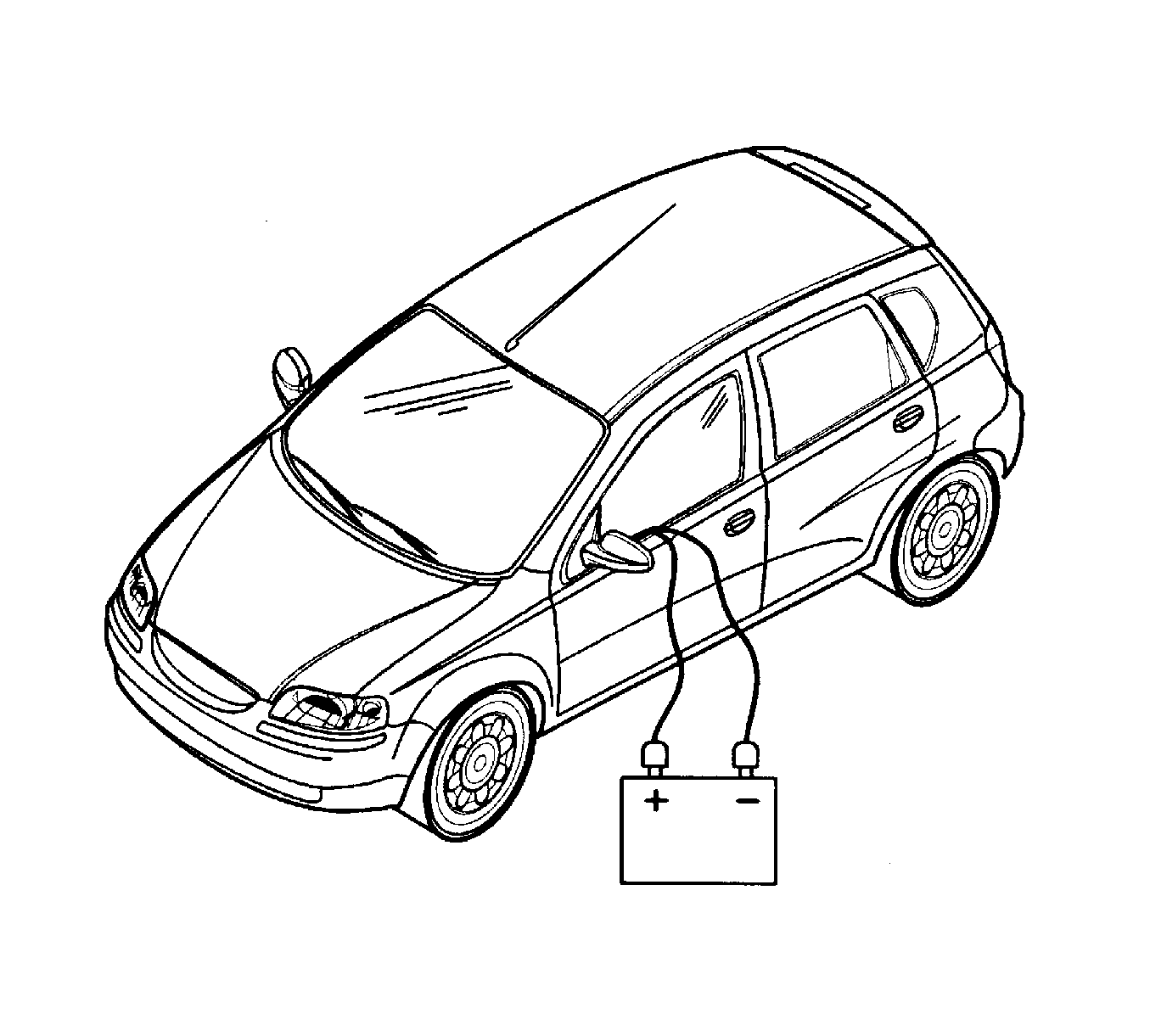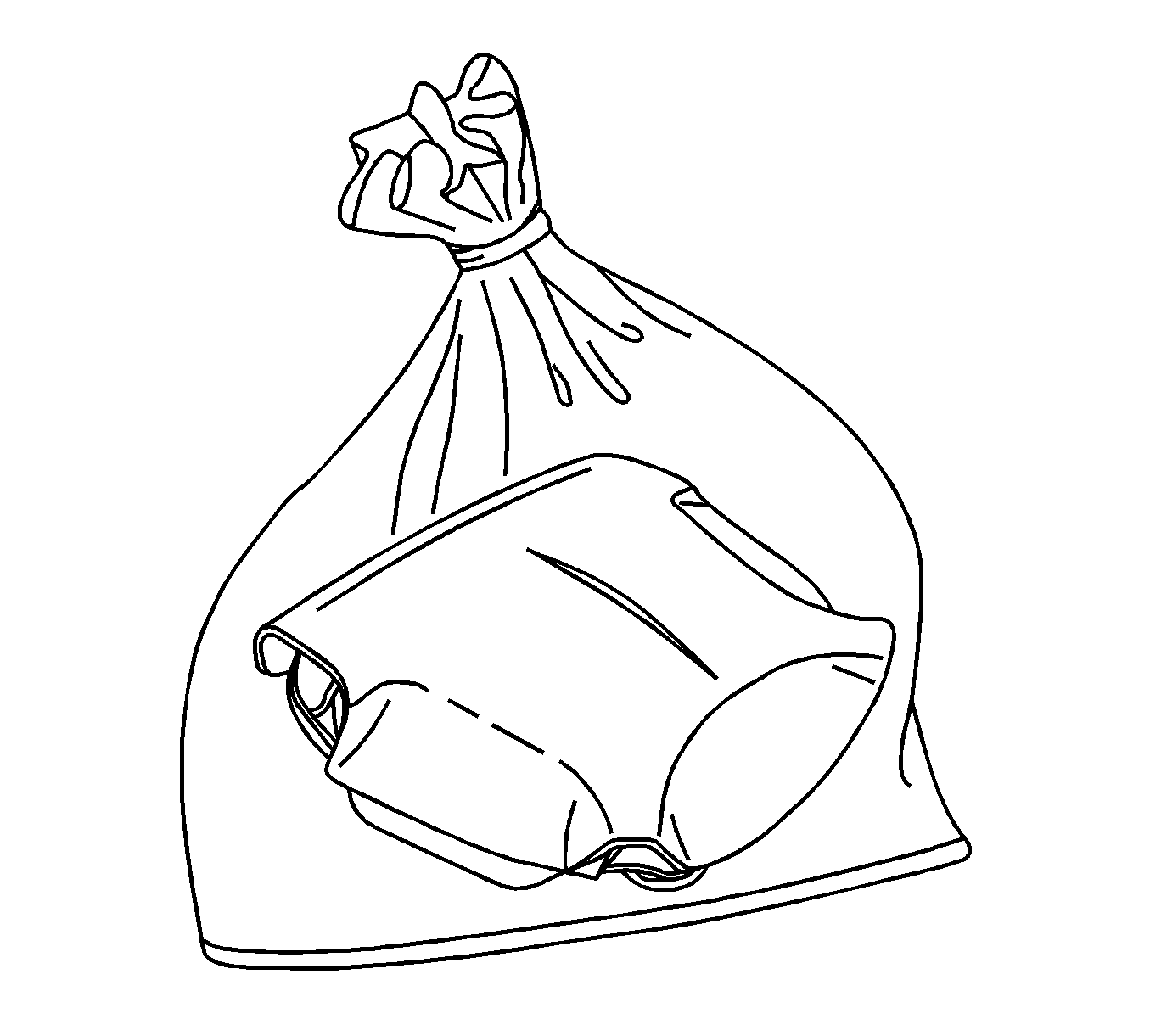Caution: Refer to SIR Inflator Module Handling and Storage Caution in the Preface section.
| • | Air bag modules should not be subjected to temperatures above 65°C (149°F). |
| • | An air bag and the SDM should not be used if it has been dropped from a height of 0.9 meters (3 feet) or greater. |
| • | When an SDM is replaced, it must be oriented with the arrow on the SDM pointing toward the front of the vehicle. |
| • | It is very important for the SDM to be installed flat on the mounting surface, parallel to the vehicle's longitudinal axis. |
| • | To avoid setting diagnostic trouble codes (DTCs), do not apply power to the SIR unless all components are connected or a diagnostic chart requests it. |
| • | The Diagnostic System Check - SIR must be the starting point of any SIR diagnostics. The Diagnostic System Check - SIR will verify proper air bag indicator operation and will lead you to the correct chart to diagnose any SIR malfunctions.
Passing these procedures may result in extended diagnostic time incorrect parts replacement. |
Inflator Module Handling and Scrapping

Deploy the air bags before disposing them. If a vehicle is to be scrapped, the air bag may be deployed inside the vehicle.
| | Caution: When deploying an airbag inside the vehicle, make sure the vehicle doors are
closed and the side windows are fully open. Wear safety glasses throughout the entire
procedure. Make sure the deployment area in the vehicle is clear of people, or loose
objects. Failure to follow these guidelines could result in personal injury or vehicle
damage.
|
| • | Before deploying the air bags, remove all loose objects from the air bag's expansion area. |
| • | Deploy the air bags with the vehicle doors closed and the side windows open. |
| • | Deploy the air bags only in an evacuated area. Service personnel who must be present during the deployment should be at least 10 meters (33 feet) in front of the vehicle. |
| • | Do not connect the voltage source until after having completed all other preparations for the deployment of the air bags. |
| • | Allow a deployed air bag module or pretensioner to cool for 30 minutes before handling. |
| • | Wear gloves and eye protection during the disposal procedure. |
| • | If the deployment fails, disconnect the voltage source and wait 5 minutes before approaching the vehicle. |
Deployment Procedure
Caution: Refer to Battery Disconnect Caution in the Preface section.
Caution: The sensing and the diagnosis module (SDM) can maintain
sufficient voltage to deploy the airbags and pretensioners for up to 1 minute after
the ignition has been turned OFF and the fuse has been removed. If the airbags and
pretensioners are not disconnected, do not begin service until one minute has been
passed after disconnecting power to the SDM. Failure to do so may cause personal injury.
- Disconnect both battery cables and place the battery at least 10 meters (33 feet) from the vehicle.
- Remove the driver side knee bolster or instrument panel lower cover from the steering column. Refer to
Instrument Panel Lower Trim Panel Replacement
in Instrument Panel, Gages, and Console.
- At the lower steering column, cut the 2 wires leading from the supplemental inflatable restraints (SIR) harness to the clock spring.
- Strip 13 mm (0.5 in) of the insulation from the end of the wires leading to the clock spring.
- Use 2 additional wires, each at least 10 meters (33 feet) long to reach from the deployment battery to the inflator module.
- Strip 13 mm (0.5 in) of the insulation from the end of these 2 additional wires.
- Twist the 2 wires together at 1 end.
- Place the twisted ends of the 2 wires near the deployment battery. Do not connect the wires to the battery at this time.
- Using the free end of the 10 meters (33 feet) wires leading to the clock spring, make 2 splices, 1 at each wire from the air bag module.
- Wrap the wires with insulation tape.
- Now that the free ends of the 10 meters (33 feet) wires are spliced to the air bag module wires, and the ends that are twisted together are near deployment battery, clear the area.
- Untwist the wires that are near the deployment battery.
- Touch 1 wire to the positive battery terminal and touch the other wire to the negative battery terminals. The air bag will deploy.
- Repeat this procedure for the passenger air bag, side air bags, and pretensioners.
- Using proper precautions, dispose of the deployed air bags and pretensioners. Refer to the Deployed Air Bag Module Disposal Procedure information in this procedure.
Air Bag Module Deployment - Outside of Vehicle
If the vehicle is within the warranty period, contact the General Motors regional service manager for approval or special instructions before deploying the air bag modules.
Deploy the air bags in the following situations:
| • | If the vehicle is to be scrapped |
| • | If an air bag module is damaged during transit, storage, or service |
| | CAUTION: When you are deploying an inflator module for disposal, perform the
deployment procedures in the order listed. Failure to follow the procedures
in the order listed may result in personal injury.
|
| • | Deploy the air bags only in an evacuated area. Service personnel who must be present during the deployment should be at least 10 meters (33 feet) in front of the vehicle. |
| • | Do not connect the voltage source until after having completed all other preparations for the deployment of the air bags. |
| • | Allow a deployed air bag module or pretensioner to cool for 30 minutes before handling. |
| • | Wear gloves and eye protection during the disposal procedure. |
| • | If the deployment fails, disconnect the voltage source and wait 5 minutes before approaching the vehicle. |
- Position the air bag module face up, on flat ground outdoors, at least 10 meters (33 feet) from any obstacles or people.
- Place a vehicle battery at least 10 meters (33 feet) away from the air bag module.
- Deploy the air bag module.
- If you do not have a deployment tool, follow the procedure below.
- Cut the yellow wires to the air bag module/pretensioner.
- Strip 13 mm (0.5 in) of the insulation from the end of the wires leading to the air bag module/pretensioner.
- Use 2 additional wires, each at least 10 meters (33 feet) long, to reach from the deployment battery to the air bag module/pretensioner.
- Strip 13 mm (0.5 in) of the insulation from the ends of these 2 additional wires.
- Twist the 2 wires together at one end.
- Place the twisted ends of the 2 wires near the deployment battery. Do not connect the wires to the battery at this time.
- Using the free ends of the 10 meters (33 feet) wires leading to the air bag module/pretensioner, make 2 splices, 1 at each wire from the air bag module/pretensioner.
- Wrap the splices with insulating tape.
- Now that the free ends of the 10 meters (33 feet) wires are spliced to the air bag module/pretensioner wires, and the ends that are twisted together are near the deployment battery, clear the area.
- Untwist the wires that are near the deployment battery.
- Touch 1 wire to the positive battery terminal and touch the other wire to the negative battery terminal. The air bag will deploy.
- Using proper precautions, dispose of the deployed air bags and pretensioners. Refer to the Deployed Air Bag Module Disposal Procedure information in this procedure.
Deployed Air Bag Module Disposal Procedure
Caution: Safety precautions must be followed when handling a deployed inflator module
(air bag). After deployment, the inflator module (air bag) surface may contain a small
amount of sodium hydroxide, a by-product of the deployment reaction, that is irritating
to the skin and eyes. Most of the powder on the inflator module (air bag) is harmless.
as a precaution, wear gloves and safety glasses when handling a deployed inflator
module (air bag), and wash your hands with mild soap and water afterwards.
Caution: Immediately following the deployment of an air bag, the metal surfaces of the
inflator module are very hot. Do not place the deployed inflator module near any flammable
objects. Wait for about ten minutes before touching any metal surface of the inflator
module. Disregarding these precautions may cause fire or personal injury.

Deploy an air bag or pretensioner before disposing of it.
This includes those in a whole vehicle being scrapped. If the vehicle is still within the warranty period, contact the General Motors regional service manager for approval or special instructions before deploying an air bag module or a pretensioner. A
deployed air bag module or pretensioner should be disposed of in the same manner as other scrap parts, with the addition to the following steps:
- Place the deployed air bag or pretensioner in a sturdy plastic bag.
- Seal the plastic bag securely.
- Wash your hands and rinse them with water after handling a deployed air bag.


